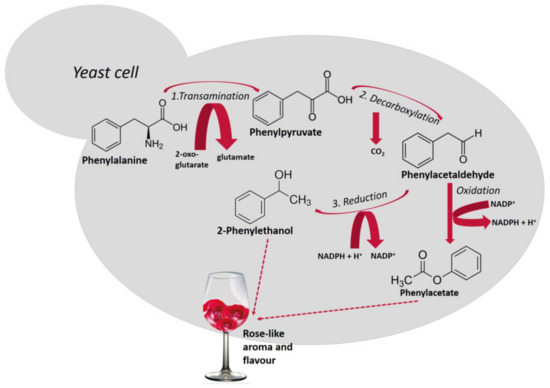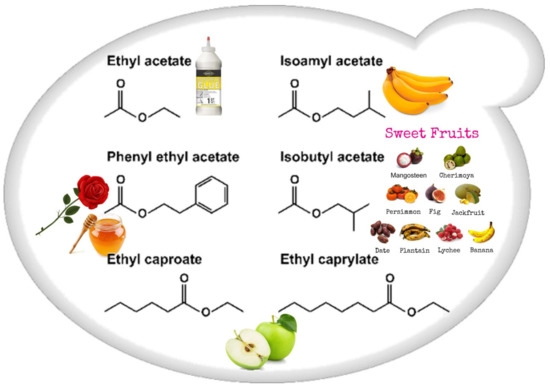1. The Human Senses in Wine Evaluation
Five senses are involved in perceiving wine sensory quality: sight, taste, hearing, touch, and smell. Color perception results from the stimulus of the retina by light (wavelengths 380 to 760 nm). In wine, color and appearance are the first attributes by which quality is assessed. According to Spence [
1], color is the most
cri
mportanttical product-intrinsic indicator
used by consumers
use when searching, purchasing, and
subsequently consuming food or a libation. Color, clarity, and hue affect the perception of other attributes
, such as flavor
, due to the
ir association with color. For example, a yellow/green beverage is expected to have a lemon flavor and an acidic taste.
Taste is a chemical sense and happens when taste stimuli co
me int
o contact with the taste receptors located on the tongue, called taste buds. Humans can distinguish six basic tastes: sweet, sour, salty, bitter, umami, and fatty [
2,
3]. Between 20 and 30 levels of intensity can be distinguished for each taste, and each taste quality represents different nutritional or physiological requirements
, or a potential dietary risk [
4].
Sound (waves
wth
ichat strike the eardrum, causing it to vibrate [
5]) is also
essenti
mportantal when judging a wine. For instance
s, when we hear a champagne cork popping, it is a sign that the wine has an enjoyable gas.
Texture in wine can be defined as the total sum of kinesthetic sensations derived from oral manipulation. It encompasses mouthfeel, masticatory properties, residual properties, and
even visual and auditory properties [
6].
Aroma and flavor are chemical senses stimulated by the chemical properties of odor molecules
, which must reach the olfactory bulb to interact with olfactory cells in the olfactory mucosa [
7]; therefore, to smell, molecules must be airborne (i.e., volatile). The sensory term
which we call “flavor” is a mingled experience based on human judgment, built on personal differences in perception thresholds.
In conclusion, a
nd as reported by Swiegers et al. [
8], all of the senses play a
keycrucial role in wine/flavor development—color, aroma, mouthfeel, sound, and
, ultimately, ta taste. Altogether, these sensory perceptions are very complex. Wine contains many flavor and aroma-active compounds. Terpenes, methoxypyrazines, esters, ethanol
, and other alcohols and aldehydes impart distinct flavors and aromas (floral, pepper, fruit, woody
, and vinylic flavors, among others) to wine [
9,
10,
11]. The taste of wine can be described as sweet, sour, salty, umami, bitter, and, to a lesser extent, fat [
12]. These properties
are the result
of the presence offrom sugars, polyols, salts, polyphenols, flavonoid compounds, amino acids, and fatty acids. Compounds such as glycerol, polysaccharides, and mannoproteins contribute to the viscosity and mouthfeel of wines [
13]; grape anthocyanins contribute to the color [
14], and ethanol, by sheer mass, also carries other alcohols along, promoting a mouth-warming effect [
15].
2. Main Wine Aroma and Flavor Compounds from the Fermentative Origin
Yeast and bacteria are vital to the development of wine flavor. Many biosynthetic pathways
, in wine yeast and malolactic bacteria
, are responsible for
the formation of forming wine aroma and flavor. However, we cannot discard the other factors
that can also influenc
eing the wine
's chemical composition, such as viticultural practices, grape-must composition, pH, fermentation temperature, and technological aspects associated with the vinification process [
8]. So, depending on their origin, wine aroma
, and flavor compounds can be named varietal aromas (originating from the grapes), fermentative aromas (
originatingcreated during alcoholic and malolactic fermentations), and aging aromas (developed during the reductive or oxidative wine-aging that depends on storage conditions) [
16].
Most of the wine aroma and flavor compounds are produced or released during wine fermentation due to microbial activities of
Saccharomyces and non-
Saccharomyces yeast genera (
Brettanomyces, Candida, Debaryomyces, Hanseniaspora, Hansenula, Kloeckera, Kluyveromyces, Lachancea, Metschnikowia, Pichia, Saccharomycodes, Schizosaccharomyces, Torulaspora, and
Zygosaccharomyces). Both in spontaneous and inoculated wine fermentations, non-
Saccharomyces are
essenti
mportant inal in the early stages of the fermentation, before
Saccharomyces become
s dominant in the culture, and contribute meaningfully to the global aroma profile of wines by producing flavor-active compounds [
17,
18].
A
group of aroma compounds ha
sve been directly linked to specific varietal flavors and
wine aromas
in wines [
19,
20]. Most of these compounds are present
at low concentrations in both in grapes and fermented wine
at low concentrations. These aroma compounds are found in grapes in the form of non-odorant precursors that, due to the metabolic activity of
Saccharomyces and non-
Saccharomyces yeast during fermentation, are transformed to aromas and flavor that are of great relevance in the sensory perception of wines [
20] (
Table 1).
Table 1. Main odorants contributinge to the varietal aromas of some monovarietal wines.
MYeainsts produce primary medium-chain fatty acids (MCFAs (C6 to C12)), pro duced by yeasts during alcoholic fermentation.
During alcoholic fermentation, some yeast, mainly non-
Saccharomyces yeasts, can release β-glucosidases that hydrolyze the glycosidic bonds of the odorless
, non-volatile glycoside
-linked forms of monoterpenes (geraniol, linalool, nerol, among others), releasing the odor compounds to the wine [
29]. Volatile thiols that give Sauvignon blanc wines their characteristic aroma (bell pepper, black currant, grapefruit, and citrus peel) are not present in grape juice but occur in grape must as odorless, non-volatile, cysteine-bound conjugates. During fermentation, the wine yeasts are responsible for
the cleaving
of the thiol from the precursor [
30].
However, the
major sig
roups ofnificant aromas and flavor compounds from the fermentative origin are ethanol, higher alcohols or fusel alcohols, and esters. The biosynthetic pathways responsible for
the formation of forming higher alcohols, the Ehrlich pathway, or the enzymes
responsiaccountable for
the formation of forming esters, have been studied in wine yeasts [
31].
Higher alcohols are derived from amino acid catabolism via a pathway
that was first described by Ehrlich [
32] and later revised by Neubauer and Fromherz in 1911 [
33]. Amino acids
tha
t are assimilated by the Ehrlich pathway (valine, leucine, isoleucine, methionine, and phenylalanine), present in grape
s must
arbe metabolized by yeasts
, sequentially
, throughout the fermentation.
Figure 1 shows the metabolism of phenylalanine with the production of 2-phenylethanol and, after oxidation of phenylacetaldehyde, the formation of phenylacetate. Both compounds possess a pleasant rose-like aroma/flavor.
Figure 1. Schematic representation of the Ehrlich pathway for the catabolism of the aromatic amino acid
, phenylalanine
, leading to the formation of 2-phenylethanol [
34]. This biosynthetic pathway consists of three steps (reactions 1, 2
, and 3): first, amino acids are deaminated to the corresponding α-ketoacids
, in reactions catalyzed by transaminases. In a in transaminase reactions. In the second step, α-ketoacids are decarboxylated and converted to their corresponding aldehydes (five decarboxylases are involved in this process)
, in a; in the third step, alcohol dehydrogenases (Adh1p to Adh6p and Sfa1p) catalyze the reduction of aldehydes to their corresponding higher alcohols [
35].
Studies have shown that profiles and concentrations of higher alcohols produced vary by yeast species, even when the fermentation conditions are similar, which indicates that the mechanisms that regulate the Ehrlich pathway are diverse in non-
Saccharomyces yeasts compared to
Saccharomyces [
16,
36]. So, Ehrlich pathway mechanisms should be explored in detail in non-
Saccharomyces yeasts as
it contributes to the
formation of importanty form essential and flavorful wine aromas [
36].
The most
cri
mportanttical esters are synthe
tsized by yeasts during alcoholic fermentation as a detoxification mechanism since they are less toxic than their correspondent alcohol or acidic precursors. Moreover, their synthesis serves as a mechanism for the regeneration of free CoA from its conjugates [
16,
37].
Esters (
Figure 2) that contribute to wine aroma, derived from fermentation, belong to two categories: the acetate esters of higher alcohols and the ethyl esters of medium-chain fatty acids (MCFA). Acetate esters are formed inside the yeast cell, and in
S. cerevisiae, the reaction is metabolized by two alcohol acetyltransferases, AATase I and AATase II (encoded by genes
ATF1 and
ATF2 [
35,
38]). Eat1p is responsible for
the produc
tion of ing acetate and propanoate esters [
39,
40]. Most medium-chain fatty acid ethyl ester biosynthesis during fermentation is catalyzed by two enzymes, Eht1p and Eeb1p [
38,
41].
Figure 2. Schematic representation of the
moess
t importantential wine esters: ethyl acetate (glue-like aroma), isoamyl acetate (banana aroma), 2-phenyl
ethyl acetate (roses and honey aromas), isobutyl acetate (sweet-fruits aromas),
and ethyl caproate and ethyl caprylate with a sour-apple aroma [
38].
Volatile fatty acids also contribute to the flavor and aroma of the wine. During yeast fermentation, long-chain fatty acids (LCFAs) are also formed via the fatty-acid synthesis pathway from acetyl-CoA in concentrations varying from ng/L to g/L [
42]. Medium-chain fatty acids (MCFAs (C
6 to C
12)) are produced primarily by yeasts as intermediates in the biosynthesis of LCFAs that are prematurely released from the fatty acid synthase complex. These acids (
Table 2) directly contribute to the flavor of wine or serve as substrates that participate in the formation of ethyl acetates [
43].
As mMost have unpleasant aromas (see
Table 2),
so their formation should be minimized.
1 Measured in model wine, water/ethanol (90 + 10, w/w) [44].
SYeasts can also form sulfur-containing compounds
can also be formed by yeasts d during alcoholic fermentation. They are usually perceived as off-flavors. The sulfur-containing compounds can be derived from the grape and the metabolic activities of yeast and bacteria. They can also occur due to the chemical reactions during the wine aging and storage and
also due to eenvironmental contamination [
45]. They can be formed by enzymatic mechanism
s as the products of metabolic and fermentative pathways whose substrates are both amino acids and some sulfur-containing pesticides. When wine microorganisms metabolize these thiols, the sulfur compounds formed are considered off-flavors [
46]
, which convey negative notes such as cabbage, garlic, onion, rotten eggs, rubber, and sulfur to wines [
47]. However,
there are some volatile thiols
that may confer enjoyable aromatic notes at trace levels, such as 4-mercapto-4-methylpentan-2-one (4MMP), 3-mercaptohexan-1-ol (3MH), already mentioned in
Table 1, and 3-mercaptohexyl acetate (3MHA),
imponecessar
tanty for the characterization of the typical Sauvignon Blanc wine aroma [
24,
25,
48].
Finally,
the ca
norbonyl compounds are another important family of aromatic compounds present in wines
are the carbonyl compounds. In t. This group
we may include acetaldehyde, acrolein, ethyl carbamate, formaldehyde, and furfural [
49]. Several factors may contribute to the presence of carbonyl compounds in wines, including the fermentation of over-ripe grapes and increasing the maceration time, probably due to increased concentration of
the precursors like amino acids and glucose in the must [
50]. Due to their carbonyl group, carbonyl compounds present a high reactivity with the nucleophile’s cellular constituents [
51] and may cause cell damage. So, these compounds are toxic, and their formation should be avoided.


